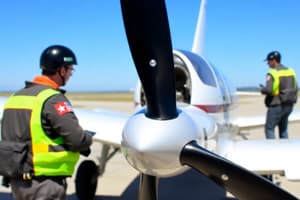Podcast
Questions and Answers
What is the primary purpose of the airworthiness requirements outlined in 14 CFR Part 23?
What is the primary purpose of the airworthiness requirements outlined in 14 CFR Part 23?
- To ensure aircraft performance in aerobatic maneuvers
- To establish minimum requirements for aircraft design and construction
- To ensure aircraft safety and airworthiness for flight training and personal flying (correct)
- To regulate aircraft maintenance and inspection schedules
What is the typical material used in the construction of airframes for FAA flight training aircraft?
What is the typical material used in the construction of airframes for FAA flight training aircraft?
- Titanium
- Carbon fiber
- Aluminum or steel (correct)
- Fiberglass
What is the primary function of redundant systems in FAA flight training aircraft?
What is the primary function of redundant systems in FAA flight training aircraft?
- To ensure safety in case of system failure (correct)
- To enhance pilot comfort
- To reduce aircraft weight
- To improve aircraft performance
What type of propellers are typically used in FAA flight training aircraft?
What type of propellers are typically used in FAA flight training aircraft?
What is the primary function of the inertial reel system in FAA flight training aircraft?
What is the primary function of the inertial reel system in FAA flight training aircraft?
What is the primary purpose of regular inspections and maintenance of FAA flight training aircraft?
What is the primary purpose of regular inspections and maintenance of FAA flight training aircraft?
What is included in the range of avionics and instruments installed in FAA flight training aircraft?
What is included in the range of avionics and instruments installed in FAA flight training aircraft?
What is the minimum horsepower rating of piston engines used in FAA flight training aircraft?
What is the minimum horsepower rating of piston engines used in FAA flight training aircraft?
Study Notes
Airworthiness Requirements
- FAA flight training aircraft must meet specific airworthiness requirements outlined in 14 CFR Part 23
- Aircraft must be certified in the normal category, which includes flight training and personal flying
- Compliance with airworthiness requirements is ensured through design, testing, and inspection
Aircraft Design and Construction
- FAA flight training aircraft are designed to withstand the stresses of flight training, including aerobatic maneuvers
- Airframes are typically made of durable materials such as aluminum or steel
- Control surfaces, such as ailerons, elevators, and rudder, are designed to be strong and responsive
- Aircraft are equipped with redundant systems, such as dual ignition systems and magnetos, to ensure safety
Propulsion Systems
- Most FAA flight training aircraft are powered by piston engines, ranging from 100 to 300 horsepower
- Engines are equipped with fixed-pitch or constant-speed propellers, which provide optimal performance and efficiency
- Fuel systems are designed to minimize the risk of fuel starvation and leaks
Avionics and Instruments
- FAA flight training aircraft are equipped with a range of avionics and instruments, including:
- Primary flight instruments: airspeed indicator, altimeter, heading indicator, and turn coordinator
- Navigation instruments: GPS, VOR, and ILS
- Communication equipment: radios and intercoms
- Engine instruments: oil pressure, oil temperature, and fuel flow gauges
Safety Features
- FAA flight training aircraft are equipped with safety features, including:
- Shoulder harnesses and seatbelts for occupants
- Firewalls and fire-resistant materials to minimize the risk of fire
- Emergency exits and emergency landing procedures
- Inertial reel systems to prevent occupant ejection during aerobatic maneuvers
Inspection and Maintenance
- FAA flight training aircraft are subject to regular inspections and maintenance to ensure airworthiness
- Inspections are performed by certified mechanics and include checks of:
- Airframe and control surfaces
- Propulsion system and fuel system
- Avionics and instruments
- Safety features and emergency equipment
- Maintenance is performed in accordance with the manufacturer's recommended schedule and procedures.
Airworthiness Requirements
- FAA flight training aircraft must meet specific requirements outlined in 14 CFR Part 23
- Normal category certification is required for flight training and personal flying
Aircraft Design and Construction
- Aircraft are designed to withstand flight training stresses, including aerobatic maneuvers
- Airframes are made of durable materials like aluminum or steel
- Control surfaces are strong and responsive
- Redundant systems, such as dual ignition systems and magnetos, ensure safety
Propulsion Systems
- Most FAA flight training aircraft are powered by 100-300 horsepower piston engines
- Engines have fixed-pitch or constant-speed propellers for optimal performance and efficiency
- Fuel systems minimize the risk of fuel starvation and leaks
Avionics and Instruments
- Primary flight instruments include airspeed indicator, altimeter, heading indicator, and turn coordinator
- Navigation instruments include GPS, VOR, and ILS
- Communication equipment includes radios and intercoms
- Engine instruments include oil pressure, oil temperature, and fuel flow gauges
Safety Features
- Shoulder harnesses and seatbelts are installed for occupants
- Firewalls and fire-resistant materials minimize the risk of fire
- Emergency exits and emergency landing procedures are in place
- Inertial reel systems prevent occupant ejection during aerobatic maneuvers
Inspection and Maintenance
- Regular inspections and maintenance ensure airworthiness
- Inspections include checks of airframe, control surfaces, propulsion system, fuel system, avionics, instruments, safety features, and emergency equipment
- Maintenance is performed according to the manufacturer's recommended schedule and procedures
Studying That Suits You
Use AI to generate personalized quizzes and flashcards to suit your learning preferences.
Description
Learn about the airworthiness requirements for FAA flight training aircraft, including design, testing, and inspection. Understand the importance of compliance with 14 CFR Part 23.




